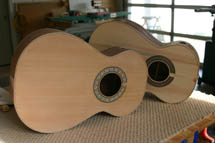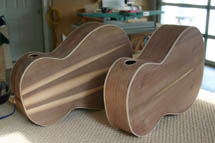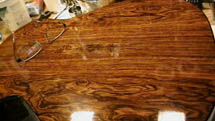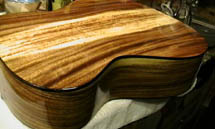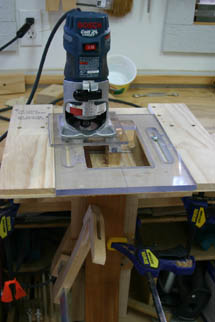Meetings
Nov 7 and 14, 2010
Meetings - November 7 and 14, 2010
Preparing for BRL night at Third Street Coffee House
We spent 2 afternoons working on a set list for our gig at the Third Street Coffee House in Roanoke - Sunday November 7th at Chet Dickerson's place and Sunday November 14th at B.B. Rierson's place.
We also saw some works in progress (below and at left).
Click on an image to see a larger picture.
Howard Wilson talks about his OMs:
In April of 2010 I was at the finishing stage of #2, an Indian rosewood/Adirondack spruce OM with bloodwood bindings for my daughter. Because the spraying requires several days of waiting between coats I decided to start on two more OM's. Since I am drawn toward wilder looking exotic woods this is what I decided to try.
The first one I chose was one for myself, finally. The back and sides are of Amazon rosewood and the top another Adirondack spruce. For bindings I picked ebony with a rosette, heelcap and end graft in spaulted African makore. The neck is mahogany from a large block that allowed me to cut two necks. It has a sound that is loud and rich with great sustain, somewhat unusual for a smaller bodied acoustic.
The second OM is composed of a little known wood for the back and sides called monkeypod. It was really fun to work it as it cut and shaped easily--reminded me of mahogany in that sense. In its unfinished stage it was decribed to me as having a tap tone of cardboard with which I agreed. I partnered it with a high grade Sitka spruce top, then added ebony bindings and more spaulted African makore to "sister" it to the other simultaneous build. Once the finish was applied the sound really came to life--almost a hybrid of mahogany and rosewood. One long standing professional player took it for a spin and said, "This looks, plays and certainly sounds better than my 1944 Martin OOO." It now has a happy home in Montana.
Larry's Staved Banjo Rim
Made from alternating walnut and maple staves.
The top side of the rim has a channel for a brass tone ring.
The bottom has a walnut cap, walnut binding, and black/white/black and maple purfling.
.
Larry's Neck Tenon Jig
This jig is a modification of the Stewmac jig.
The back of the jig was modified to enable clamping on a benchtop.
The face of the jig was narrowed to allow easier clamping of the neck.
Small pieces of sandpaper were put on the face of the jig and the shim block to stop the neck from sliding around.

